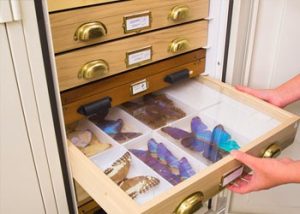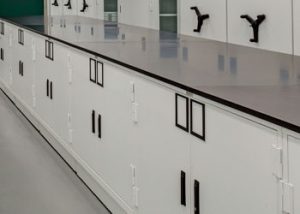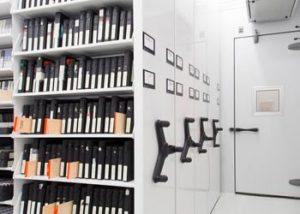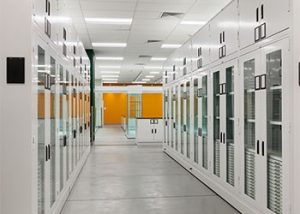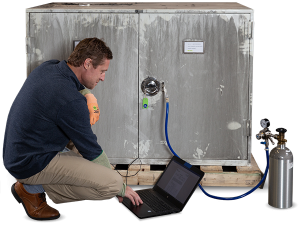Mitigating Damage
How the right storage solutions can help mitigate damage
The right storage solutions can help mitigate damage by providing the appropriate environment and conditions for collections. By controlling temperature and humidity, as well as providing adequate ventilation and light filtration, you can create an environment that will slow the rate of deterioration of your collection.
DIRECT PHYSICAL FORCES
Sudden shock or long-term pressure that can break and deform objects.
There are three primary ways to mitigate the effects of direct physical forces: anti-tip rail systems, anti-tip bars, and closed rib nuts. Anti-tip rail systems provide stability and reliability for compact shelving in seismically active areas. Anti-tip bars prevent objects on shelves from accidental falls and spills. Closed rib nuts on cabinets allow cabinets to be attached to one another for additional stability.
Academy of Sciences
If you’re looking for a reliable storage solution for your hospital or package locker users, Spacesaver is a great option. Our engineers have designed our storage solutions to be compact and mobile, while still accommodating specimens preserved in liquid. We understand that special care must be taken when storing such specimens, particularly in seismically active areas, so we’ve equipped our storage solutions with earthquake bars and partial doors. This way, you can rest assured knowing that your specimens will be safe and sound, no matter what Mother Nature throws your way.
CONTAMINANTS
Collections care best practices protect from acids and pollution that are airborne, transferred by contact, or intrinsic to the collection.
Spacesaver cabinets and shelving are an ideal storage solution for hospitals and other care facilities that need to protect their collections from contamination. The cabinets feature non-off-gassing paint to avoid chemical contamination, and the sealed design helps keep objects away from potentially harmful airborne pollutants
Field Museum
If you’re looking for a high-quality storage solution that will keep your collections safe from contamination, Spacesaver Museum Cabinets are the perfect choice. Our cabinets feature fumigant-resistant elastomeric gaskets for a secure door seal, a 3-point latch to ensure the cabinets are airtight, and non-off-gassing paint to prevent chemical deterioration. Hospitals and other package locker users will appreciate the added security and peace of mind that our cabinets provide.
THIEVES, VANDALS & DISPLACERS
People steal or maliciously damage objects. Museum personnel can simply misplace them.
How to Mitigate
- PIN code access
- Physical locks
- Key card access
- Audit trail to track who has accessed collections
Security
We’ve installed keyed and digital locks on cabinets and compactors at many museums as a final line of defense against theft of valuable objects. Digital locks also allow an audit trail to track who last accessed the cabinet in case of a missing object.
.
INCORRECT TEMPERATURE
High temperatures speed up the chemical deterioration of unstable materials.
How to Mitigate
- Smaller collections are recommended to use upright refrigerators or freezers.
- Medium sized collections are recommended to use shelving or museum cabinets housed in walk-in coolers.
- Large institutions are recommended to use compactors housed in cold rooms and walk-in freezers.
The Museum of Nature and Science recently built a cooler and freezer to house its image collection. This was done in order to consolidate the collection in climate-controlled spaces and to protect the materials. With the help of a Spacesaver representative, the museum was able to create a compact cold storage solution that would save space, improve organization and efficiency, and comply with applicable codes. This solution has been beneficial for the museum and has helped them to better protect their valuable collection.
PLANNING FOR COLD STORAGE PRESERVATION
WATER
Floods, leaky roofs, or slow drips from pipes can damage collections irreparably.
How to Mitigate
- Steel compactors can raise shelving 4”-6″ to help avoid shallow floods.
- Metal shelving stands up to water better than wood or particle board.
- Cabinets should have waterproof caps, rather than seams in the top.
Coolers and freezers provide the best possible preservation environment for film and a variety of other materials, so they’re essential components of most museums’ risk management strategies. Cold storage is expensive to build and operate, though, so it’s important to understand the needs of various materials in your collection and carefully plan for the move to cold storage.
How to Plan & Implement a Move to Cold Storage
Cold storage is expensive storage. You can keep building costs and operating costs down by planning carefully and making the most of every square inch. Here’s how to plan your cold storage space.
- ASSESS COLLECTION
Identify materials that need cold storage and sort by items that need cold storage, frozen storage, or typical archival storage. Measure the amount of space required to store items that currently need to be maintained in cold storage and frozen storage, and add curators’ estimates for future space needs.
WHAT NEEDS TO BE STORED IN COOL OR COLD CONDITIONS?
Negatives (glass plate negatives, sheet film, roll film)
Slides (or any type of transparency)
Motion picture film and videotape
Microfilm and microfiche
X-ray film
Photographic prints
Cellulose nitrate film*
- DEVELOP A USAGE POLICY / PROCEDURE
Describe how researchers and others will request access to stored materials, who will be entrusted with access to cold storage areas, where and how materials will be acclimated as they are brought into and out of cold storage, and where and how researchers will be allowed to study materials after they’re brought out of storage.
- DETERMINE WHERE ITEMS WILL BE STORED
Smaller collections can be stored in refrigerators or freezers, but be sure to use models that maintain a constant temperature. Medium-sized collections can be stored on shelving or museum cabinets housed in small walk-in coolers. Larger collections are generally stored in compactors housed in purpose-built cold rooms and walk-in freezers.
Museum risk management cold room optimize space
PLANNING IS KEY
Although cold storage is expensive, it doesn’t have to be out of reach for your institution. Careful preparation and planning can help build a system that ensures materials are preserved for future generations — and that provides room to grow in the future.
- CREATE A PLAN FOR MOVING TO COLD STORAGE
Work with vendors to coordinate delivery and installation dates, and determine who will be responsible for scanning (if desired), cataloging, acclimatizing, and moving items. Determine procedures to monitor temperature and relative humidity, and prominently post contact information for vendors in case of equipment malfunction.
- OPTIMIZE SPACE WITHIN THE COOL ROOM OR FREEZER
Adjust shelving to avoid wasting space between shelves, and use compactors (high-density mobile shelving) to consolidate materials. The more items you can store, the more you’ll save, both in initial building costs (due to a smaller footprint) and in ongoing energy costs (a full cooler or freezer operates more efficiently).
FIRE
Fire, smoke, and soot destroy and stain objects.
How to Mitigate
- Powder coat finish
- Cabinet gasket seal
- Corrugated panel
Cabinet Testing
The Preservation Cabinet 920 Series is the perfect solution for hospitals and package locker users who need to protect their belongings from fire damage. The cabinet can withstand temperatures of up to 900 degrees Celsius (1650 degrees Fahrenheit), making it ideal for storing items in high-risk areas. Plus, the cabinet is water-resistant, so you don’t have to worry about your belongings getting wet if a sprinkler system is activated.
OTHER AGENTS, OTHER SOLUTIONS
Radiation/Light
Radiation from light waves fades and embrittles sensitive material.
Pests
Insects and rodents eat and nest in organic collections. Mold consumes and stains organic material in humid conditions.
Neglect
When collections storage best practices are not maintained, objects can be separated from their records or other items in the collection.
Relative Humidity
As different collections have different requirements, there is no single correct relative humidity level.
Contact us today for help designing your new police station.


